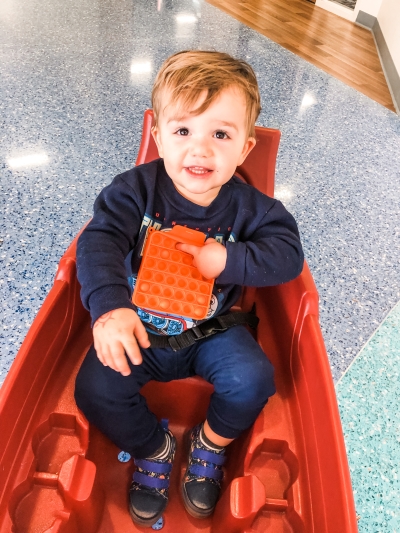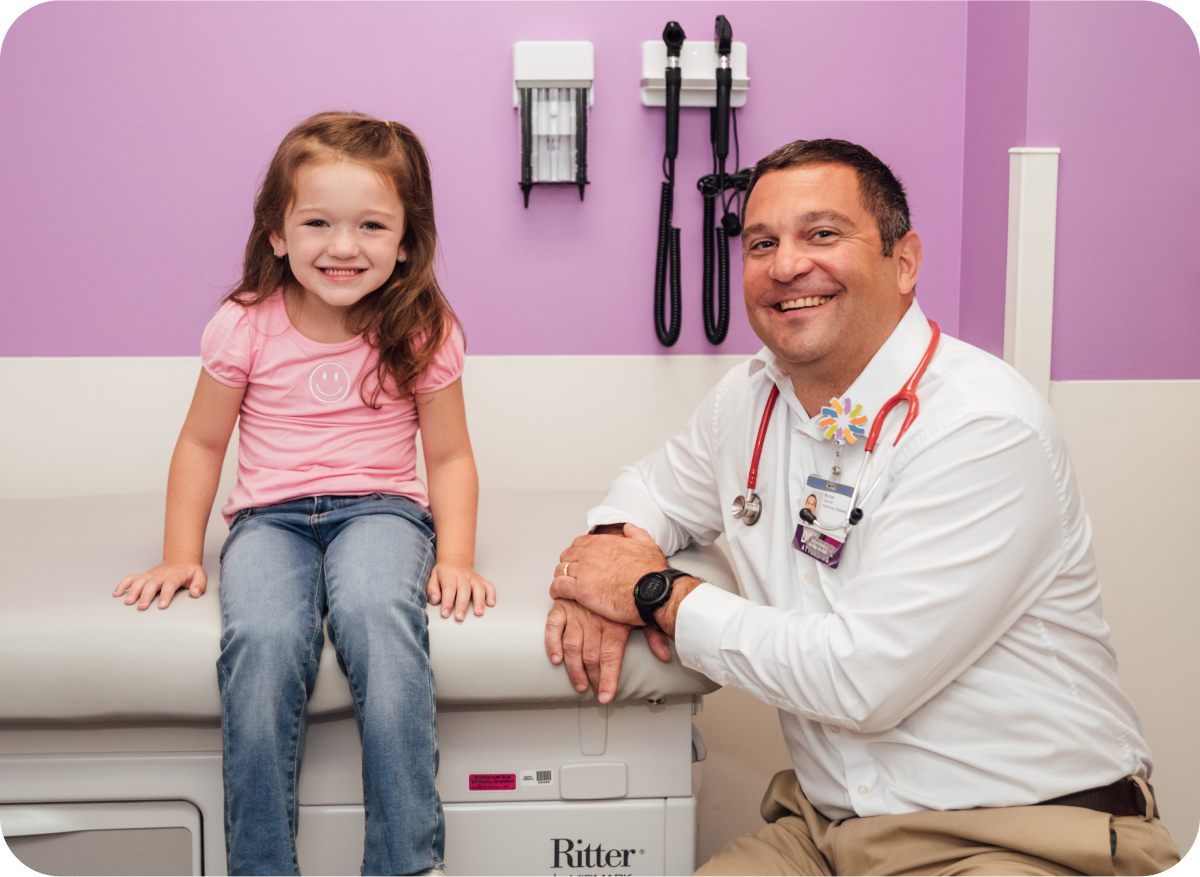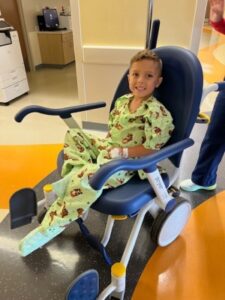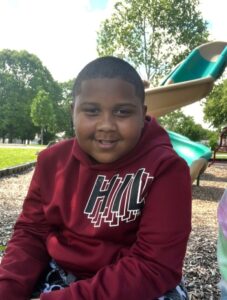Peter Jones
finding answers – the road to a rare disease diagnosis

- patient name: Peter Jones
- age: 3
- condition: dysphagia and myasthenia gravis
- seen in: neurology, gastroenterology and nutrition, ENT, speech therapy
We’ve all had the experience of taking a sip, coughing and remarking “ouch! It went down the wrong pipe!” But when Peter’s parents noticed their 15-month-old coughing and choking every time he drank, they began to wonder “is this normal?”
As the second child in the family, Peter’s parents, Grace and Zack, knew that something seemed different from their first as he weaned off breastfeeding and transitioned to a sippy cup.
“It was happening so often that I started taking videos of him during meals so I could show the doctor. I thought maybe I was just crazy,” says Grace.
At Peter’s 15-month well-child visit Grace asked their pediatrician, Dr. Morrison, about the issue.
“She encouraged me and said she was glad I brought it up. This isn’t something that would be noticed during a regular visit, so it was important for me as the parent to ask the question and bring it to her attention.”
Dr. Morrison referred Peter to Dayton Children’s Hospital for a swallow study.
A swallow study is an imaging test that required Peter to drink liquids of various thicknesses while X-rays were taken. It was found that Peter was in fact aspirating his liquids. This means the liquid was entering his airway and going into his lungs instead of his stomach.
Peter was diagnosed with dysphagia, meaning difficulty swallowing. It was recommended that Peter only drink from one type of bottle and all liquids must be thickened. To help him with this new regimen, Peter began feeding therapy in the speech/language pathology department at Dayton Children’s.

the question of why?
Even with some answers and validation, the family was still after the question of why this was happening. Dr. Morrison shared four options of specialists they could see to try to figure out the issue… ENT, gastroenterology, pulmonary and neurology.
In June, Peter saw Dr. Ravi Elluru, pediatric ENT specialist. Through a laryngoscopy, Dr. Elluru was able to rule out any sort of structural issue potentially causing dysphagia. He suspected potentially some reflux and prescribed medication. However, after a month of trying the medicine there was no improvement.
In August, Peter was seen in the division of gastroenterology and nutrition. There, they discussed taking a wait-and-see approach for a few months before any additional interventions. Peter could simply grow out of dysphagia and they wanted to see if in a few months it might resolve on its own.
But come November there was still no improvement. Peter’s gastroenterology care team recommended both an MRI and an endoscopy.
knowing what we’re up against
“When I heard that we were moving toward a MRI, I began asking questions and doing research on neurological causes of dysphagia,” says Grace. “Anytime someone suggests something could be wrong with your child’s brain, it’s not something you take lightly. I wanted to know what we might be up against.”
In her research one diagnosis leapt off the page… myasthenia gravis (MG).
Myasthenia gravis happens when connections between nerves and muscles get blocked. It causes weakness in the voluntary muscles (the muscles we can control). The weakness can come and go, and vary from mild to severe.
Myasthenia gravis is rare: about 10 in one million people are diagnosed each year, and just 10 percent of those diagnosed with the condition are children (source – Children’s Hospital of Philadelphia) .
Yet for Grace, this condition was not unknown. Two members of her family, her grandma and brother, both had MG.
“I immediately messaged our GI specialist through MyKidsChart and mentioned the connection. I asked to be referred to Dr. Irma Reyes in neurology because I found on Dayton Children’s website that she had experience with MG.”
Peter did not present as the typical MG patient. One of the tell-tale signs of MG is ptosis, a drooping of the eyelid, which Peter did not have. His only known symptom at this point, was the difficulty swallowing. But with the family connection, Dr. Reyes agreed that it was worth doing some blood work.


a positive diagnosis
A week later, Dr. Reyes called Grace.
“I had been getting messages on MyKidsChart every time one of the tests came back negative, so as soon as I heard her voice on the phone, I knew something was different,” remembers Grace. “She talked to me for nearly a half hour that day explaining Peter’s positive myasthenia diagnosis, the medicine he would be starting and how she wanted to see him again as soon as possible so we could start on a treatment plan.”
Dr. Reyes prescribed pyridostigmine. Peter takes this four times a day, every day. But thanks to the medication, Peter was able to wean off of the thickened liquids and the bottle. He will continue to follow up with Dr. Reyes twice a year to monitor his condition.
“We are so incredibly thankful for Dr. Reyes,” says Grace and Zack. “The fact that we have someone right here at Dayton Children’s who can treat myasthenia is beyond amazing. Dr. Reyes goes above and beyond to answer questions we have both at appointments and in between.”
While there is a chance Peter could go into remission with his MG, it is most likely something he will manage his entire life. Peter’s parents are constantly on the lookout for other symptoms that might be related to his MG.
“It’s hard to know with a toddler because they can’t always communicate clearly,” says Grace. “When your child has a condition that could get worse, it’s hard not to question every little thing.”
finding support
One thing that has helped, says Grace, is connecting with other families through Facebook groups. Through these condition specific groups, Grace has been able to glean advice from other MG parents and also guide those who receive a new diagnosis.
“I’m always encouraging parents to never give up advocating for their kid,” says Grace. “I find that not everyone is as fortunate to have a hospital like we do with doctors who listen and are willing to search for answers. Whether it’s MG, or another rare disease, finding an answer can be a long and difficult process.”
“I like to remind parents that no one knows their child better than them. If you think something seems off, start by simply asking the question and don’t give up until you have an answer.”
share your story
Every patient journey at Dayton Children’s is powerful — from NICU miracles to courageous cancer survivors and beyond. These patient stories not only celebrate our families but also offer hope and encouragement to others facing similar challenges. Share your experience today and help inspire, support, and celebrate the strength of our patients and families.

care that goes above and beyond
Because every child deserves care that goes above and beyond, Dayton Children’s provides compassionate, expert care for kids of all ages. Find a provider, schedule an appointment, or learn more about conditions we treat today.




